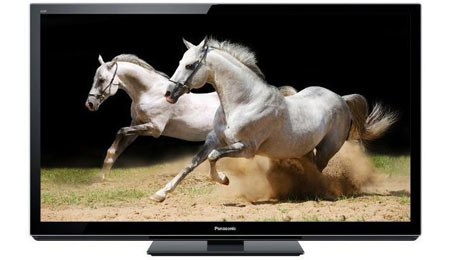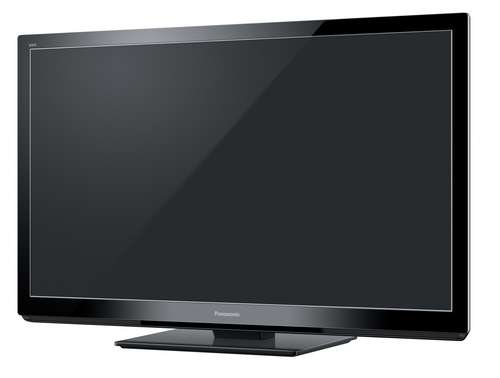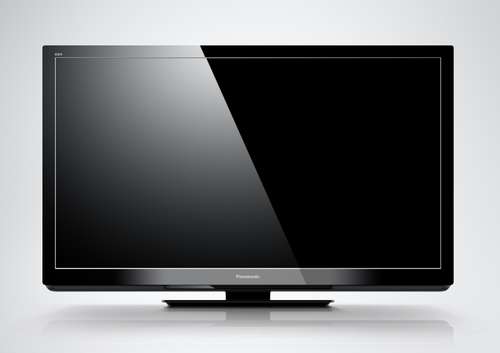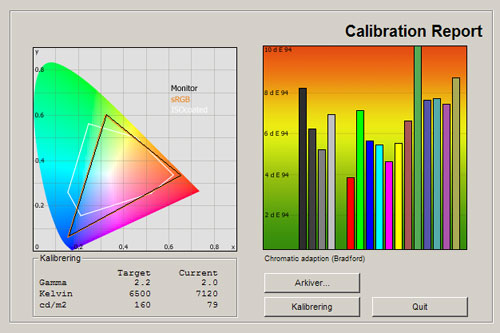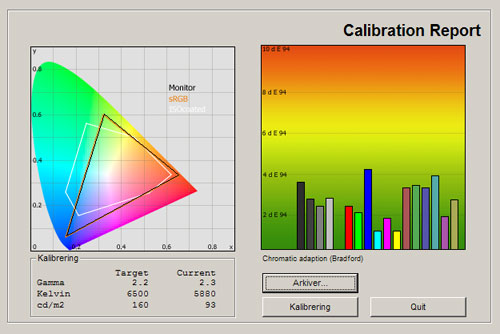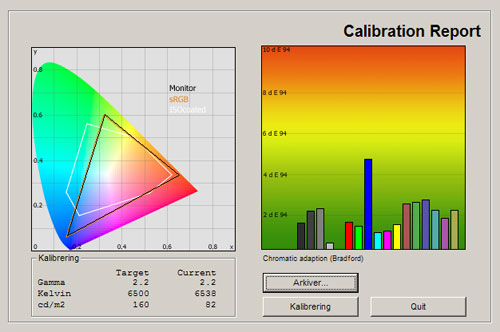Review: Panasonic GT30
Panasonic GT30 review
Panasonic’s 2011 flat panel TVs will be available in stores very soon and we have the first TV from the 2011 line-up. It’s the GT30 with the new Infinite Black 2 panel, 3D and the all-new Viera Connect Internet system. And not to forget; the new ultra slim design.
But has Panasonic improved picture quality even further with their 2011 TVs? Can the new mid-end GT30 compare to last year’s flagship VT20 model? And has the 3D picture quality improved as well? FlatpanelsHD intends to find out in this Panasonic GT30 review.
Panasonic GT30 is available in 50, 55, 60 and 65 inches called TC-P42GT30, TC-P50GT30, TC-P55GT30, TC-P60GT30 and TC-P65GT30 in the US. Panasonic GT30 is available in 42, 46 and 50 inches called TX-P42GT30, TX-P46GT30 and TX-P50GT30 in EU.
Subscribe to our Newsletter to receive e-mails when new reviews are online. We’ll soon publish our Samsung C9000, LG Cinema 3D, Toshiba WX800/WL768 and Sony EX720 reviews as well.
Size: 50" widescreen Resolution: 1920x1080 Response time: 0.001 ms Contrast ratio: 5,000,000:1 Brightness: - Color support: 16,7 million colors Signal processing: 8 for each color Viewing angles (H/V): Angle Free Dot pitch: Panel type: Plasma TV Wall mounting: Swivel stand: Dimensions (HxWxD): 71.8cm x 117.7cm x 3.3cm (without stand) Weight 25.5 kg Built-in speakers: Input formats: 480p/i, 576p/i, 720p, 1080i & 1080p (50, 60 & 24p) Inputs VGA DVI (but possible to convert through HDMI)
Audio (type) (Audio in/out)
SCART (1 input)
S-video Composite Component HDMI (4 inputs, 1 HDMI 1.4)
Other Outputs Audio (type) (1 output, headphones)
SCART S/PDIF (optical)
Other Tuners Analogue DVB-T DVB-T (MPEG4) DVB-C DVB-C (MPEG4) DVB-S DVB-S (MPEG4) Other Price and retailer:
| US retailer | UK retailer |
 |
Our first impressions
In the past Panasonic has not focused much on design but in 2011 things will change. Panasonic has slimmed down their TV models and designed a new slimmer and more elegant frame in glossy black.The lines are sharper, less rounded and the build quality is still good. At the same time you feel that it’s a Panasonic TV. It’s not just a design rip-off – it has soul and clear Panasonic references.
We quickly turned our attention to the slimmer frame. It’s not just slimmer; it’s significantly slimmer than what we’re used to from Panasonic’s plasma TVs. And that’s not all. The inputs are not pointing out towards the wall but instead to the side and down. Good move, Panasonic.
The stand is made from metal and has a plastic design layer on top. It has swivel function, too.
I must admit that I was not a huge fan of the old Panasonic design but the new slimmer GT30 is elegant. It’s not just that it’s thinner and less bulky but the new sharper lines makes it look modern.
We noticed some very light buzzing coming form the back of the TV. However, it was not noticeable from 1-2 meters away.
Test tools
Our TV signal is DVB-S (satellite) from Canal Digital and DVB-T (terrestrial). We also have an analogue TV connection. Testing is done with the DVE (digital video essentials) and Peter Finzel test DVD. Testing is also done with DVD, TV, Blu-Ray and Media center/PC.We use our own monitorTest. The software supports some of the traditional test patterns used to evaluate displays as well as some new and unique test patterns developed by the people here on FlatpanelsHD.
Sony PlayStation 3 is our Blu-Ray player.
All contrast measurements are based on the ANSI methodology.
Functionality
Below you see the remote control. Not much new here.Panasonic has reused and polished last year’s functionality which means that you can expect USB recording (in Europe), DLNA and a lot of calibration option. The new features include the Viera Connect internet platform with a Viera Market App store. Panasonic has also redesigned their menu interface, although navigation is the same.
To learn more about USB recording and DLNA, see our G20 review here. It’s basically the same functionality in GT30.
A new addition is Viera Connect and Viera Market. So let’s take a look at the Viera Connect platform. The start-screen is seen below.
From here you can select different services but the menu structure has not changed much compared to the 2010 models. The new cool addition is Viera Market that basically is an App store as you already know from most mobile devices and in particular Apple’s popular devices.
Apps and available services vary depending on your country and local services will also be available in the store. Above you see the “Feature” page and below you see the “Games” page with Apps available from the Viera Market store at the time of writing (in EU).
I didn’t count but there’s not much available at the moment. The most active category is actually the Games category with 14 mini games for your pleasure. This is the very start of Viera Connect and Viera Market and we hope Panasonic manages to attract many more developers in the coming months and years.
It certainly looks interesting at this point and Viera Market is a nice addition.
Calibration settings
In the menus Panasonic GT30 has these picture setting options: contrast, brightness, colour, sharpness, color balance, vivid color, color remaster, eco mode, P-NR, and Picture in Picture.
In the advanced menu you can control: white balance (RGB), gamma, IFC (Intelligent Frame Creation), Resolution Enhancer, 16:9 overscan, and pixel orbiter.
You can also choose from these picture modes: Dynamic, Normal, Cinema, THX, Game, Photo, Professional1, and Professional2.
Energy consumption
Below I have measured energy consumption on the 50-inch model of GT30. |  | |
| Standby | 0.1 W | 0.1 W |
| SD+HD | 133 W | 169 W |
| 3D | 190 W | 190 W |
After calibration I measured power consumption to 169 W, which is lower than on VT20/VT25 from 2010 that consumed 190 W after calibration. The out-of-box power consumption has also been reduced significantly compared to previous Panasonic plasma TVs.
I have also included a measurement of the 3D energy consumption. In the 3D mode the backlight is often maxed out to compensate for the reduction in light from the 3D glasses. Therefore the 3D mode also typically consumes more energy.
Calibration on Panasonic GT30
Below you can see an out-of-box measurement on Panasonic GT30 in the Standard picture preset without Eco mode.The graph says this:
The number on the left is the delta value. Delta is a difference between two factors; here it’s the difference between the measured color on the panel and the actual color that is our target.
The out-of-box picture quality is not very accurate and most colors are oversaturated. The color temperature is also slightly too high meaning that the picture is a bit too bluish and cold. This is very common and seen on pretty much every TV with the standard picture settings.
I measured gamma rising form 1.7 in the dark shades to 2.3 in the bright shades, which means that the dark colors are too dark (and some detailing is crushed) and the bright colors are marginally too bright.
I changed to the picture preset called THX and took a new measurement.
The THX mode is very accurate - as expected. Panasonic has used the THX modes on their TVs for a few generations now and we have always been impressed with the results.
The THX mode gives picture quality very close to the picture standards that movies are edited according to, and therefore you get images similar to those the director had imagined for his or her movie.
In the THX mode I measured gamma from 2.2 to 2.3, which is not 100 % accurate but very close to our 2.2 target. The color deviations are also very small. The color temperature is a bit too low, however. This gave us slightly too warm and reddish pictures.
Brightness was measured to 93 cd/m2, which is enough for most viewing but not as bright as LCD/LED models. Also, Samsung’s plasma TVs are still able to output more light from the panel.
I now did a calibration on GT30 to tweak the THX preset further. Here’s my result.
After calibration I achieved fantastic picture quality – even better than in the THX preset. The gamma is still not 100 % accurate but very close.
Color deviations are also very low and the color temperature is perfect.
Below are my calibrated settings.
 | |
| Viewing mode: | Professional1 |
| Contrast | 35 |
| Brightness | +1 |
| Colour: | 30 |
| Sharpness: | 2 |
| Color Remaster: | Off |
| Eco | Off |
| P-NR | Off |
| Gamma | 2.2 |
| Intelligen Frame Creation | On/Off |
| Resolution Enhancer | Off |
| 16:9 Overscan | Off |
| R-Gain | +1 |
| G-Gain | -8 |
| B-Gain | 7 |
| R-Cutoff | 0 |
| G-Cutoff | -1 |
| B-Cutoff | +1 |
I have used most of the THX picture settings but have also changed the RGB (red, green, blue) values for better color accuracy. Most of the dynamic circuits have been disabled but some people prefer to have IFC (Intelligent Frame Creation) on and that’s why it says On/Off in the table above.
One thing I noticed with the new menu layout in the TV menus is that the menu covers all of the screen area. This is extremely frustrating when trying to calibrate colors because you have to go back and forth between the menu and the measurement area. Please change that, Panasonic.
Picture quality on Panasonic GT30
In this section I go through picture quality with the calibrated settings.Plasma panels are made from glass and therefore reflections occur. GT30 has a very good anti-reflective screen and coating, however, and even in the daytime with heavy light I felt that picture quality was crisp and that black was deep and intense. This is important because many plasma TVs still struggle to reproduce the same high standard of picture quality in bright surroundings. See the picture below.
Color gradation is just as important as color accuracy. You want a TV to be able to distinguish colors from each other and we examine this with smooth color gradients. GT30 does a pretty good job but it’s not perfect. We saw some “bands” in the darker areas of our smooth gradient, which means that the TV has trouble reproducing all of the darker shades.
This is mostly due to the fact that plasma TVs still use dithering to create some colors and it’s a tough issue to overcome for manufacturers. It also means that you once in a while see some banding in practical use in for example movies. It’s not critical but it’s there and it’s definitely something Panasonic needs to work on in the future. Banding has not been reduced compared to the 2010 models such as the VT20/VT25.
SD picture quality (TV and DVD) is really good and this was expected. Panasonic’s plasma TVs have previously been some of the best for standard definition material and GT30 is no exception. The SD pictures are detailing and crisp and even in fast motion detailing is extremely high.
HD picture quality (Blu-ray and HD games) is fantastic and detailing is beautiful. GT30 looks almost identical to last year’s top range models in terms of HD picture quality and that’s a good thing. I did see some dithering in the darker colors that were mostly visible from a short distance but it’s at the same level as most plasma TVs and not really a concern.
Response time is very fast and it really contributes to picture quality in sports, games and action. As I have said before Panasonic’s plasma TVs maintain a high level of detailing even in fast motion and this is of great importance because you very seldom watch static pictures on a TV. The faster response time also means that GT30 is a better companion for console gaming than LCD/LED TVs.
Input lag is lower than on the 2010 models, and was measured to 18-25 ms. The level of input lag depends on the circuits enabled and IFC adds to input lag. Input lag on Panasonic GT30 is also lower than on most LCD/LED models. This also means that GT30 is great for console gaming.
Phosphor trailing was greatly reduced when Panasonic introduced their 2010 3D models that utilized a new phosphor. This faster phosphor has been used in GT30 as well and therefore phosphor trailing is very low. It’s not eliminated and I saw it in our stress test but GT30 does a great job, even though it has not been improved compared to the high-end 2010 Panasonic TVs.
The IFC (Intelligent frame creation) system is not very different from last year’s models and I have already said it before. It helps to smooth out movement and it’s not as aggressive as Samsung’s 200/240 Hz systems, but for most viewing I personally prefer to turn it off.
I tried to force retention and I was able to see a very tiny hint of retention but I was positively surprised to learn that Panasonic has made great improvements compared to the VT20/VT25 from 2010. The flagship VT-model in 2010 also used the new faster phosphor but at the same time it introduced more retention that on previous Panasonic plasma TVs. This has been reduced significantly on GT30 and I didn’t see anything in practical use. I was able to trigger light retention after a few hours with a static picture but it’s not a big issue on GT30.
Below I have measured black level and contrast.
 |  | |
| Black level | 0.03 cd/m2 | 0.03 cd/m2 |
| Brightness | 79 cd/m2 | 82 cd/m2 |
| Contrast ratio | 2633:1 | 2733:1 |
Contrast ratio +/- 50
After calibration – and before - I measured black level to 0.03 cd/m2. This is not pitch black but comparable to Panasonic’s high-end models from 2010. The black level leaves room for improvement but it also proves that Panasonic still has some of the best black levels on the market. Also, black levels on GT30 have been improved visibly in bright environments based on the new anti-reflective coating.
Shadow detailing on GT30 is great. The Standard picture preset was not convincing because of the wrong gamma but the THX preset, and with our calibrated settings, we pretty much got perfect detailing in dark movies and games.
We did see some plasma/dithering noise (small flickering in the pixels) in the very dark grey tones but only from a close distance.
Below I have examined the Panasonic GT30 a completely dark room to see if it has clouding, backlight bleeding or floating black issues.
GT30 has no issues whatsoever.
3D picture quality on Panasonic GT30
We used the PlayStation 3 and a 3D Blu-ray player to test 3D movies and 3D games.Panasonic has not chosen to include 3D glasses with GT30.
I won’t say too much about 3D in general and what you should expect but instead refer to our Panasonic VT25 / VT20 review for a general 3D introduction.
In this test I want to examine 3D depth, 3D picture quality, 3D crosstalk and finally include a small comparison to some of the other 3DTVs on the market.
Panasonic GT30 outputs more light than most plasma TVs but I don’t see a huge improvement over last year’s VT20/VT25. For very bright rooms it still lacks a higher light output but for typical rooms and dark rooms its fine.
I went on to examine the 3D pictures and was particularly interested in crosstalk and 3D depth. Panasonic had the lowest crosstalk together with LG’s 3D plasma in 2010 and Panasonic has promised even better performance in 2011.
And crosstalk is very low, yes. I only saw it a very few times in very high contrast pictures. It’s not eliminated but it’s almost invisible to the eye. The low crosstalk also contributes to fantastic 3D depth. I used our reference material but I also had a chance to watch the Avatar 3D Blu-ray.
Avatar looked great in 3D on the GT30. The 3D depth was fantastic and I personally think that 3D – if executed in the right manner - contributes significantly to the visual experience. Try to put this effort into something with a non- Pocahontas story line and I think more and more people will see the benefit of 3D, and the subtle but yet powerful addition it is to storytelling and visual telling.
The THX mode is also available in 3D mode now to ensure accurate colors (the 2010 models had inaccurate colors in the 3D mode).GT30 still has some pixel dithering in 3D (and in 2D) but once you put on the 3D glasses it’s extremely hard to notice.
All in all GT30 is a fantastic 3D TV and I believe that the performance is almost identical to last year’s high-end VT25 / VT20 model, which is also our 3D reference. At the same time it means that Panasonic currently has the best 3D picture quality on the market and once again we see that plasma is a far superior choice when it comes to 3D picture quality.
The 3D glasses are still a bit clumsy and too heavy. The new ones introduced in September 2010 are definitely better and lighter but still far from perfect.
PC and Media Center
The TV supports 1:1 pixel mapping. In order to achieve 1:1 pixel mapping you need to select the aspect ratio called “Just" in the OSD.Viewing angles
The viewing angles are very wide as we have come to expect from a plasma panel. The change in color intensity is minimal and contrast is also maintained even from wide angles – most LCD/LED TVs today suffer from huge drops in contrast from wide angles.See the picture of the viewing angles below.
Sound quality
Panasonic GT30 is slimmer than previous Panasonic TVs but the cabinet has been widened at the bottom of the cabinet in order to make room for larger speakers.The speakers are okay and better than speakers in most of the very slim LCD-TVs with LED but they certainly lack bass and punch. Voices are clear, however. The speakers are fair for most all-round TV use but not more than that.
For movies, games and music I recommend separate speakers.
Conclusion
Panasonic GT30 has - like most of Panasonic's other new 2011 TVs – many useful multimedia features built in. First of is the USB recording function (on EU models) and DLNA that lets you stream video, images and music from other electronic devices. But the most exciting new addition is Viera Connect and Viera Market, which is Panasonic's"App" Internet platform and"App store". Viera Market still lacking content but it certainly has potential with the open platform, and we’re looking forward to following the development.Panasonic GT30 has fantastic 2D picture quality based on accurate and natural colors, deep black levels similar to last year's high-end models, incredibly fast response time, and low phosphor trailing. Shadow detailing is on GT30 is high, which ensures great-looking games and movies. GT30 still has some problems with banding (colors not clearly separated) but it’s certainly not critical.
3D picture quality is beautiful as well and the best on the market. It’s not an improvement over last year’s VT20/VT25 model in terms of crosstalk but GT30 has a 3D THX mode to ensure accurate colors in 3D movies. 3D glasses are bought separately.
Panasonic GT30 has very few cons and I’m sure that most users will feel that the new design with connectors facing downwards and to the side is a welcome change. Panasonic GT30 is also very close – of not on par – with last year’s high-end models and it truly is a great TV. Therefore it received our warmest recommendations and is awarded with our Top Recommendations Award.

Press the award logo to learn more.
Price and retailer:
| US retailer | UK retailer |
 |
 |  |  |
| Picture quality | No 3D glasses included | Living room |
| Black depth | Some dithering & banding | Home Cinema |
| 3D picture quality | Buzzing not completely eliminated | |
| Open Viera Connect platform | Viera Connect lacks content | |
| Motion resolution | ||
| Functionality and USB recording | ||
| Inputs pointing down and to the side |
Subscribe to our Newsletter to receive e-mails when new reviews are online. We’ll soon publish our Samsung C9000, LG Cinema 3D, Toshiba WX800/WL768 and Sony EX720 reviews as well.

